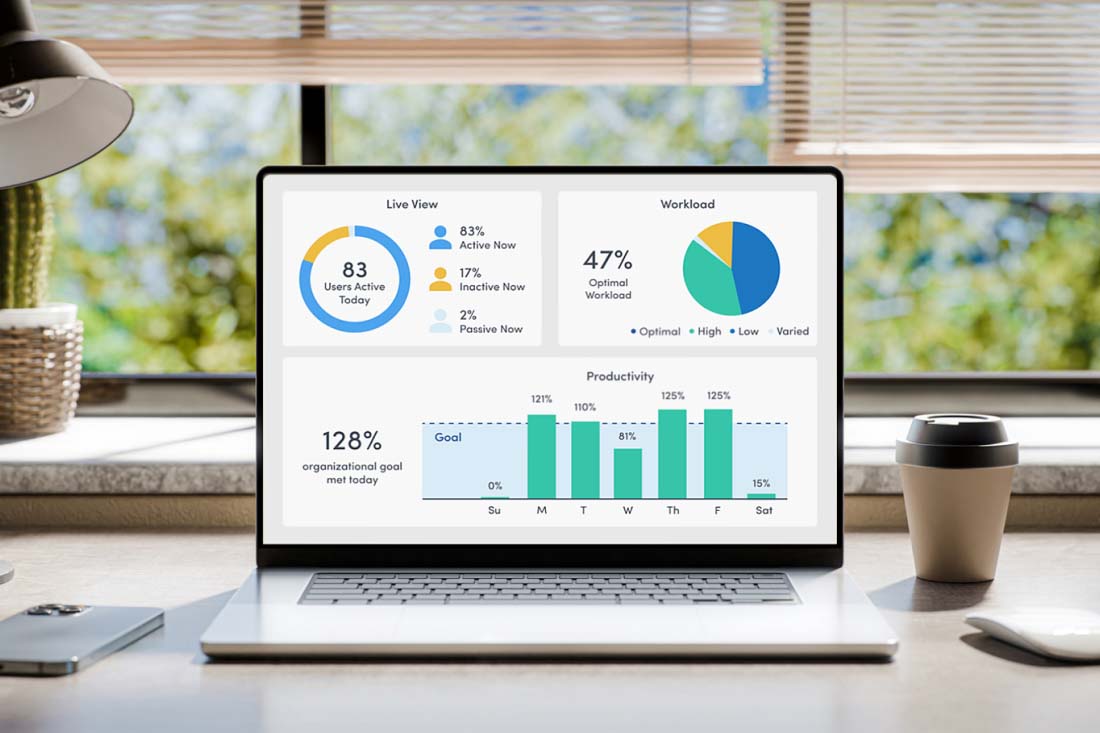There is no shortage of buzz about building a productive workplace culture, but what does that really mean? And how do organizations go about creating these types of optimized environments? Foundationally, you need to define what productivity means for your organization, understand the cultural shifts required for it to thrive, and identify the steps needed to achieve it. Then, make it happen.
What Is Productivity?
Productivity is a ratio of inputs to outputs.
Inputs are productivity enablers to align people, process, and technology.
Outputs are unique to each team or business and reflect what’s produced.
What Is a Continuous Productivity Improvement Culture?
A continuous productivity improvement (CPI) culture is an ethos and environment in which productivity naturally flourishes, as an extension or evolution of a culture of continuous improvement. In these settings, leaders and employees continuously evaluate how work can be done more efficiently and effectively. CPI cultures also prioritize investing the time and resources necessary to make and sustain positive change within the organization.
What Does a Continuous Productivity Improvement Culture Look Like?
Although creating a productivity-centric culture takes effort, CPI environments can become self-sustaining once best practices are established and embedded. These cultures are found in organizations, workplaces, and teams where innovation thrives and employees at all levels of the organization feel engaged and empowered to contribute ideas.
Organizations with cultures of continuous productivity improvement prioritize training and development. Employees are comfortable asking for help and support whenever needed and leaders are quick to respond to those requests. CPI cultures purposefully seek out opportunities to remove productivity obstacles and provide team members with the resources needed to do their work efficiently and effectively.
A continuous productivity improvement requires intense, and rewarding, focus at the organizational level. Everyone’s work aligns with the organization’s goals and has a clear understanding of the strategies and methodologies used to achieve them.
Culture drives behavior, behavior drives activity, and activity drives productivity.
Now that we have a better understanding of what a continuous productivity improvement culture looks like, let’s talk about developing one. Here are five ways you can improve the productivity culture of your organization.
1. Reinforce Your Vision Regularly
Employees must be clear about what they’re working to produce. Being productive (working on the right tasks and objectives) without having an aligned vision can lead to workplace drift and disengagement. However, when employees believe in the organization’s vision and strategy, they’re more likely to have increased buy-in, stay engaged, and remain committed to the process.
Aligning on vision creates an empowering environment where employees take the initiative without waiting for managers to tell them what to do next. Driven by their independent excitement for achieving organizational goals, they can utilize their skills and capabilities to take ownership of projects and pride in their contributions.
2. Talk Openly (and Honestly) About Productivity Behaviors and Data
Teams must talk openly and honestly about these topics to create a culture where productivity thrives. The more you discuss productivity data and behaviors, the more comfortable employees become in voicing their concerns on expectations.
Similarly, leaders are more transparent in sharing their own productivity challenges. In doing so, they can help surface issues that impact others across the organization.
Reliance on managerial observations or survey data alone as productivity feedback does not capture the gaps and opportunities. Experienced managers can sometimes intuitively spot dips or departures from typical performance, that’s not always the case.
Employees may express concerns on company surveys, but such feedback tools are lagging indicators. Relying on this unreliable, and incomplete, feedback means you’ll be learning about employees’ struggles or frustrations too late to provide support.
A workforce analytics software, like ActivTrak, is a more comprehensive option to gain real-time insights regarding the inputs and outputs that yield employee productivity. By tracking applications, workload, and other activities, organizations can quickly assess how employees are spending their time and determine if additional resources or workload adjustments are needed.
3. Set Productivity Goals and Help Your Organization Reach Them
Goals require organizational alignment, purpose, and focus and play a key role in developing a CPI culture. Workforce productivity is often overlooked during the traditional goal setting process.
You can encourage employees to be productive and stay focused, but management must do their part, too. Once you establish productivity metrics and goals, the next question from leadership teams should be, “What do you need to accomplish these goals, and how can I help?
ActivTrak’s Workforce Intelligence Dashboard provides insights and analysis on productivity, pinpoints inefficiencies, and captures critical user activity information. The dashboard, and other features, help teams stay on track and mitigate roadblocks as they surface.
4. Measure the Impact of Your Productivity Improvement Efforts
Investments in productivity can be small (e.g., procedural changes) or large and expensive (e.g., major technology upgrades). Either way, it’s essential to see that those investments are having an impact for two primary reasons:
- Confirm that employees have seamless access to the support they need
- Determine if investments have yielded the intended outcomes
With many organizations shifting to fully remote or hybrid models, observing and assessing productivity becomes even trickier. How can you objectively compare the outputs of distributed teams? What steps can you take to ensure that both on-site and remote employees remain productive across different environments?
ActivTrak provides several ways to measure the effectiveness of productivity improvement efforts and assess the adoption of new tools and investments. Our User Activity and Productivity Reports help managers see which applications are consuming employees’ time and uncover stagnant workflows.
These reports track tasks and hours for employees and measure the effectiveness of new operating procedures or technologies. Leadership can also compare team performance real-time, to generate and guide conversations between managers and share best practices.
5. Identify Where Friction Exists Amongst Teams
Friction is caused when distractions and multitasking activities pull us away from working productively, such as the constant ding of message notifications and email alerts, and task switching after co-worker interruptions.
Often, employees don’t realize they’re losing productivity. Without objective data, it’s hard to illuminate these blindspots (or correct them).
Backed by data, managers can have informed conversations with employees as a first step in mitigating friction. Early intervention identifies distractions and provides the support needed to unlock productivity potential, not just for a single individual but for the entire team and organization.
ActivTrak provides this critical data, and a suite of tools to analyze and optimize operational efficiency. Using curated reports, management teams can identify which software may be causing context switching interruptions or spot inefficient processes and workflows. These insights can highlight training opportunities to maximize available tools and empower employees to high performance.
Productivity is a continuous process
Even if your organization has already created an environment of thriving productivity, continuous attention and optimization is critical to maintaining it.
And if you’re just getting started or struggling on the path to a CPI culture, following the principles we’ve laid out above will get you to the finish line. No matter where you are in the journey, remember that trust and transparency are paramount. A leadership team that drives and embodies continuous improvement, provides support where necessary, and invests in their people elevates everyone’s performance.
Create your Own Culture of Productivity Improvement for Free
Take the next step by signing up for a free ActivTrak account. To learn more about improving your workforce productivity , check out the ActivTrak Productivity Lab.
About ActivTrak and The Productivity Lab
ActivTrak helps companies unlock productivity potential. Our award-winning workforce productivity and analytics software provides expert insights that empower people, optimize processes, and maximize technology. With data sourced from more than 8,500 customers and 250,000 users, ActivTrak’s Productivity Lab is a global center for ground-breaking workforce productivity research and expertise that helps companies embrace and embody the future of work.




